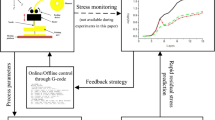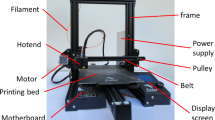Abstract
Fused deposition modeling (FDM) has been widely applied in the automotive, aerospace, industrial, and medical fields in recent years. However, residual stress and part deformation caused by thermal effects are still significant issues that limit the development of the technology. Improving the temperature control system has been shown to be an efficient way to reduce thermal effects. In this work, nozzle temperature and platform temperature were first studied to provide experimental data for modifying a control system. Identical parts were printed using different settings and distortion was measured for each part. Then, based on the distortion data, a cyber-model was built to predict deformation based on printing settings. The prediction test results show that a linear regression model outperformed an artificial neural network model and a support vector machine model. Based on the linear regression model, a cyber-physical system (CPS) was built to adjust nozzle temperature settings automatically. A performance evaluation experiment showed that this CPS system can reduce the distortion significantly. In future research, printing speed control and platform temperature control will also be included in the CPS system to further decrease the distortion.
Similar content being viewed by others
References
Lee J, Bagheri B, Kao H-A (2015) A cyber-physical systems architecture for industry 4.0-based manufacturing systems. MFGLET 3(Supplement C):18–23. https://doi.org/10.1016/j.mfglet.2014.12.001
Gunes V, Peter S, Givargis T, Vahid F (2014) A survey on concepts, applications, and challenges in cyber-physical systems. TIIS 8(12):4242–4268
Rajkumar RR, Lee I, Sha L, Stankovic J (2010) Cyber-physical systems: the next computing revolution. ACM:731–736
Baheti R, Gill H (2011) Cyber-physical systems. The Impact of Control Technology 12:161–166
Herterich MM, Uebernickel F, Brenner W (2015) The impact of cyber-physical systems on industrial services in manufacturing. Procedia CIRP 30:323–328
Lee J, Lapira E, Bagheri B, Kao H-A (2013) Recent advances and trends in predictive manufacturing systems in big data environment. MFGLET 1(1):38–41. https://doi.org/10.1016/j.mfglet.2013.09.005
Wang L, Törngren M, Onori M (2015) Current status and advancement of cyber-physical systems in manufacturing. J Manuf Syst 37(Part 2):517–527. https://doi.org/10.1016/j.jmsy.2015.04.008
Crump SS (1992) Apparatus and method for creating three-dimensional objects. Google Patents
Weiss KP, Bagrets N, Lange C, Goldacker W, Wohlgemuth J (2015) Thermal and mechanical properties of selected 3D printed thermoplastics in the cryogenic temperature regime. IOP CONF SER MATER SCI ENG 102(1):012022
Gibson I, Rosen DW, Stucker B (2010) Rapid manufacturing technologies, rapid prototyping to direct digital manufacturing. Springer
Caffrey T (2013) Additive manufacturing and 3D printing state of the industry annual worldwide progress report. EMR 2(1):209–222
Bellehumeur C, Li L, Sun Q, Gu P (2004) Modeling of bond formation between polymer filaments in the fused deposition modeling process. J Manuf Process 6(2):170–178
Sood AK, Ohdar RK, Mahapatra SS (2009) Improving dimensional accuracy of fused deposition modelling processed part using grey Taguchi method. Mater Des 30(10):4243–4252
Es-Said OS, Foyos J, Noorani R, Mendelson M, Marloth R, Pregger BA (2000) Effect of layer orientation on mechanical properties of rapid prototyped samples. Mater Manuf Process 15(1):107–122. https://doi.org/10.1080/10426910008912976
Zhang Y, Chou K (2008) A parametric study of part distortions in fused deposition modelling using three-dimensional finite element analysis. Proc Inst Mech Eng B J Eng Manuf 222(8):959–968
Zhang Y, Chou Y (2006) Three-dimensional finite element analysis simulations of the fused deposition modelling process. Proc Inst Mech Eng B J Eng Manuf 220(10):1663–1671
Sahu RK, Mahapatra S, Sood AK (2013) A study on dimensional accuracy of fused deposition modeling (FDM) processed parts using fuzzy logic. IJMSP 13(3):183–197
Mohamed OA, Masood SH, Bhowmik JL (2016) Optimization of fused deposition modeling process parameters for dimensional accuracy using I-optimality criterion. Measurement 81:174–196
Kantaros A, Karalekas D (2013) Fiber Bragg grating based investigation of residual strains in ABS parts fabricated by fused deposition modeling process. Mater Des 50:44–50. https://doi.org/10.1016/j.matdes.2013.02.067
Wang T-M, Xi J-T, Jin Y (2007) A model research for prototype warp deformation in the FDM process. Int J Adv Manuf Technol 33(11):1087–1096. https://doi.org/10.1007/s00170-006-0556-9
Sun Q, Rizvi GM, Bellehumeur CT, Gu P (2008) Effect of processing conditions on the bonding quality of FDM polymer filaments. Rapid Prototyp J 14(2):72–80
Dinwiddie RB, Love LJ, Rowe JC (2013) Real-time process monitoring and temperature mapping of a 3D polymer printing process. SPIE defense, security, and sensing. International Society for Optics and Photonics, 87050L
Zhou X, Hsieh S-J, Sun Y (2017) Experimental and numerical investigation of the thermal behaviour of polylactic acid during the fused deposition process. Virtual Phys Prototy 12(3):221–233. https://doi.org/10.1080/17452759.2017.1317214
Nagy HM, Watanabe K, Hirano M (2002) Prediction of sediment load concentration in rivers using artificial neural network model. J Hydraul Eng 128(6):588–595
Zhou X, Hsieh S-J, Peng B, Hsieh D (2017) Cycle life estimation of lithium-ion polymer batteries using artificial neural network and support vector machine with time-resolved thermography. Microelectron Reliab 79:48–58
Vapnik V (2013) The nature of statistical learning theory. Springer science & business media
Meshram PM, Kanojiya RG (2012) Tuning of PID controller using Ziegler-Nichols method for speed control of DC motor. IEEE, pp 117–122
Ang KH, Chong G, Li Y (2005) PID control system analysis, design, and technology. IEEE Trans Control Syst Technol 13(4):559–576
Spoerk M, Gonzalez-Gutierrez J, Sapkota J, Schuschnigg S, Holzer C (2018) Effect of the printing bed temperature on the adhesion of parts produced by fused filament fabrication. PLAST RUBBER COMPOS 47(1):17–24
Xinhua L, Shengpeng L, Zhou L, Xianhua Z, Xiaohu C, Zhongbin W (2015) An investigation on distortion of PLA thin-plate part in the FDM process. Int J Adv Manuf Technol 79(5):1117–1126. https://doi.org/10.1007/s00170-015-6893-9
Acknowledgments
Any opinions, findings, and conclusions or recommendations expressed in this material are those of the authors and do not necessarily reflect the views of the Texas A&M University, Rockwell Automation, or Taiwan’s Ministry of Education (MOE).
Funding
This material was partially supported by a Texas A&M University-CONACYT Collaborative Research Grant (No. 230308), by a gift from Rockwell Automation, and by the Additive Manufacturing Center for Mass Customization Production, which is part of the Featured Areas Research Center Program within the framework of Taiwan’s Ministry of Education (MOE) Higher Education Sprout Project.
Author information
Authors and Affiliations
Corresponding author
Rights and permissions
About this article
Cite this article
Miao, G., Hsieh, SJ., Segura, J.A. et al. Cyber-physical system for thermal stress prevention in 3D printing process. Int J Adv Manuf Technol 100, 553–567 (2019). https://doi.org/10.1007/s00170-018-2667-5
Received:
Accepted:
Published:
Issue Date:
DOI: https://doi.org/10.1007/s00170-018-2667-5




